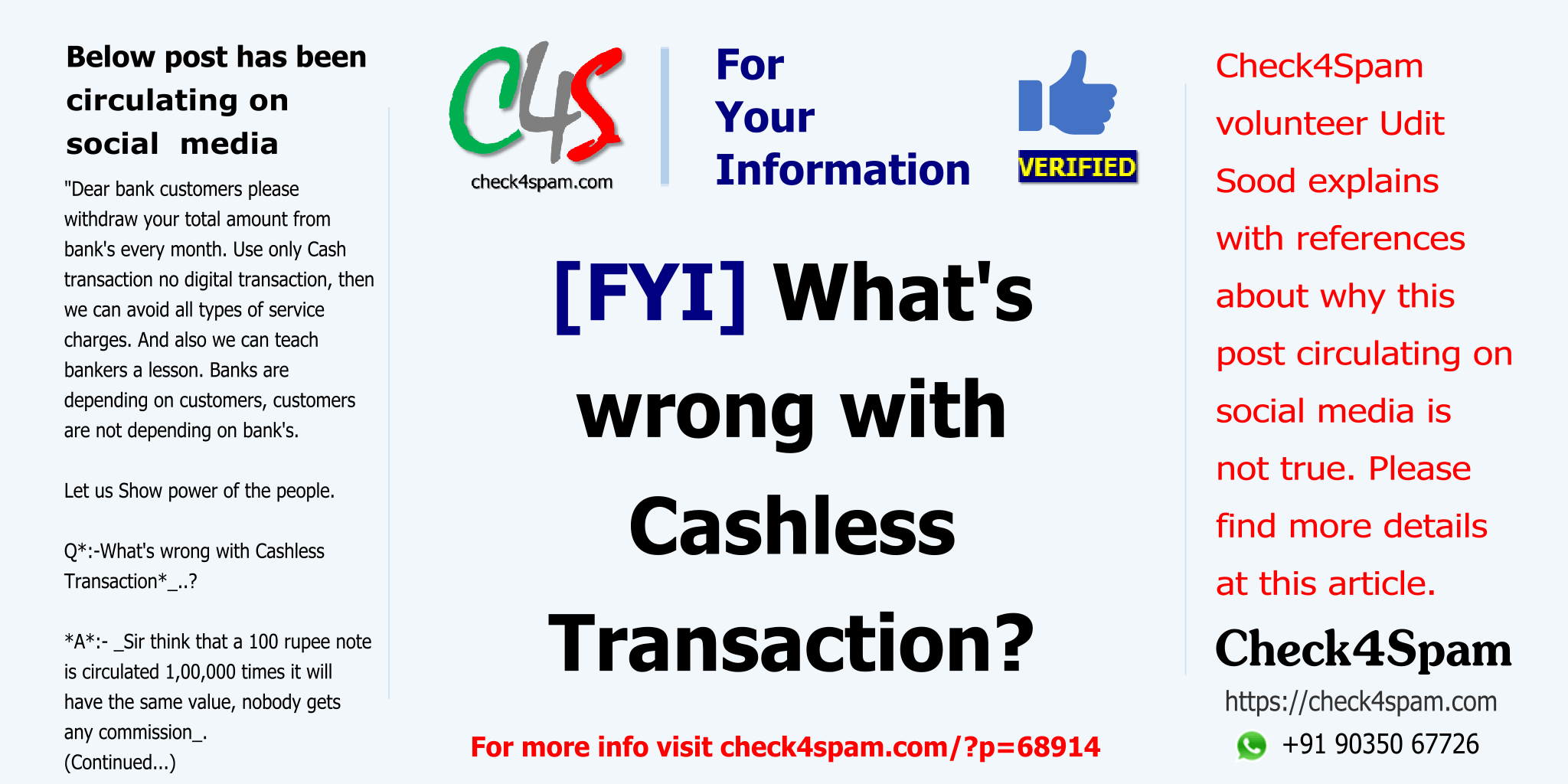[FYI] What’s Wrong with Cashless Transaction?
This is a For Your Information post about some facts related to the post shown below circulating on social media about Cashless Transactions. Readers are requested to share their thoughts and views.
Post Information:
Below posts have been circulating on social media
“Dear bank customers please withdraw your total amount from bank’s every month. Use only Cash transaction no digital transaction, then we can avoid all types of service charges. And also we can teach bankers a lesson. Banks are depending on customers, customers are not depending on bank’s.
Let us Show power of the people.
Q*:-What’s wrong with Cashless Transaction*_..?
*A*:- _Sir think that a 100 rupee note is circulated 1,00,000 times it will have the same value, nobody gets any commission_._But if it is circulated through cashless transactions, each transaction fetches *2.5%* commission, that means 1,00,000 times 2.5% = 2500% i.e. Rs. 2,50,000 (Rs. Two Lakhs fifty thousand Rupees) to service providers like Paytm or Jio Money etc. *Just for hundred rupees*_.So, it’s a perpetual golden egg laying goose gifted to the gang_. That’s why this is the *Mother of all scams* Very important statistics please read & understand, no politics in this_. Do you know*…1) _Debit Cards charge between 0.5% to 1% to the retailer Or money receiver for every transaction_.2) _Credit Cards charge beteen 1.5%-2.5% to the retailer of the money receiver for every transaction_.3) _PayTM/Freecharge/ Jio Money and other E-wallets charger 2.5% -3.5% when you want to transfer your e-wallet money into your bank a/c_.RBI data shows that every month around 2.25 lakh crore (Anually Rs 25 -30 lakh crores) is withdrawn from ATM’s across India. And it is estimated that along with bank withdrawals, a total of Rs 75 lakh crore is withdrawn ( both banks and ATMs) on a yearly basis. All this is accounted/tax-payed money which is withdrawn from banks. Currently, just 3% of transactions are in electronic mode_…If this 75 lakh crore is converted into a *#cashlesseconomy*, look at how much the companies will earn.. (75 lakh crores times 2% average) Rs 1.5 lakh crore per year!_…*NO KIDDING!**This is the biggest open scam. Direct benefit for Corporates like Reliance, PayTM, e-Banks etc. of Rs 1.5 lakh crores per year*_…This makes me wonder, was Demonetization done to end black money or was it actually done to benefit Corporate.”
Verification:
(by Udit Sood)
First of all, it is not possible for any economy to reach 100% cashless, if we will reach there then we can track any expense any income of the people of our country and can make corruption to almost nil.
Now as there are numerous transactions of different values with having different discounts and cashback schemes that it is almost impossible to calculate the exact service charge charged by these digital banking players. Still let us assume that the value given for all these companies to make by these digital transactions as 1.5 Lakh crore Rupees is correct.
Still as per Schneider estimation, using the dynamic multiple-indicators multiple-causes method and by currency demand method, that the size of India’s black money economy is between 23 and 26% of the GDP which is 9.5 trillion $ PPP, which is roughly Rs. 617.5 Lakh crores of which 25% is Rs. 154.37 Lakh crores. This figure is still 100 times higher than the amount corporate will make after India going fully digital and reducing corruption to almost nil.
Second of all, the basis of any service charges is a service provided or consumed, in case of mobile wallets and banks there is a service provided to customers on which they are supposed to be charged. These banks and mobile wallets has to run in profits to keep alive and at the same time they are also working under market conditions where different players are competing and are at the optimum levels of services and profits. In case someone hike the profits, the other one will grab the business and that’s how competitive economy works.
Last of all, below are a few visible advantages of cashless economy:
- Attack on black money (in visible terms of land and jewelry)
- Financial Inclusion
- Increase the Tax Net
- Boost in Consumption
- Security and Convenience
References
- Friedrich Schneider (September 2006). “Shadow Economies and Corruption All Over the World: What Do We Really Know?” (PDF). Institute for the Study of Labor (IZA Bonn).
- Frey and Schneider (2000). “Informal and Underground Economy” (PDF).
- List of countries by GDP (PPP) | Wikipedia
Post Date: 19th August 2017
Post ID: #68914
Thank You for visiting Check4Spam. Kindly leave a comment at this article if you like our service.




![[SPAM] Paytm Cash 1000 for 4 Right Answers](https://dbuhyrqqtene9.cloudfront.net/wp-content/uploads/2018/03/post-69246.png)









